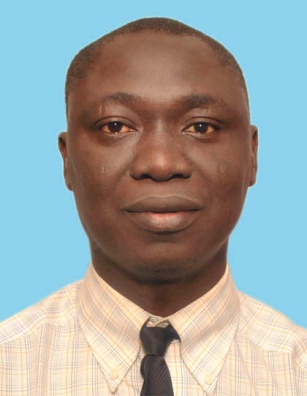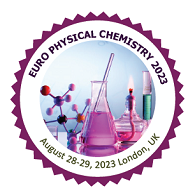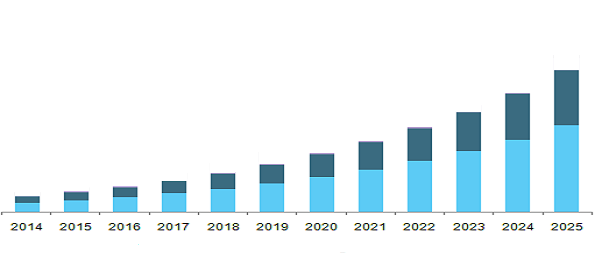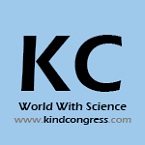Sessions/Tracks
Track 1: Physical Chemistry and Macromolecules:
The area of chemistry known as physical chemistry is concerned with the physical characteristics of chemical compounds. It is one of the standard subfields of chemistry and is defined as the application of physics' concepts and theories to the study of matter's reactivity and chemical properties. It focuses on the physical laws that underlie all chemical interactions, as opposed to other branches, and seeks to measure, correlate, and support the quantitative components of reaction. In an effort to explain, correlate, and support the quantitative features of reactions, it deals with the physics principles that underlie all chemical interactions (such as the gas laws). The smallest particles that are rarely handled in the field of physical chemistry, atoms and molecules, have been modelled by quantum physics in great detail. This has allowed theoretical chemists to use computers and sophisticated mathematical techniques to understand the chemical behaviour of matter. The relationship between various chemical energies, heat, and reaction rates is the focus of chemical thermodynamics. Chemical science, photochemistry (see photochemical reaction), surface chemistry, and catalysis are all examples of subfields of chemistry. The study of the chemical underpinnings of fundamental biological systems is known as biochemistry. At its core, biochemical research seeks to define the relationship between the structure and utility of biological macromolecules. More specifically, biochemical research has contributed to a more thorough understanding of hereditary disease infectious disease, organ and tissue transplantation, regenerative medicine, and clinical diagnostics.
Track 2 :Chemical Kinetics and Reaction Engineering:
Chemical Reaction Engineering is a specialisation in industrial chemistry or chemical engineering that manages chemical reactors. It is also known as reaction engineering or reactor engineering. The word is frequently used to refer especially to chemical action reaction systems when the reactor has either a homogeneous or heterogeneous catalyst. Chemical reaction engineering attempts to explain the most basic reactor design by studying and optimising chemical reactions. In order to connect reactor performance to feed composition and operating circumstances, it is crucial to consider the interactions of flow phenomena, mass transfer, heat transfer, and reaction dynamics. Chemical kinetics includes investigations into how various experimental conditions can affect a chemical process's speed and produce information about the mechanism and transition states of the reaction, as well as the creation of mathematical models that can be used to describe the properties of a chemical process. In chemical engineering, chemical kinetics offers information on residence time and heat transfer during a chemical reactor, and as a result, the molar mass distribution in polymer chemistry.
Track 3 :Solution and Thermodynamics:
The study of how heat and work interact with chemical processes or with physical changes in state under the purview of the rules of thermodynamics is known as solution thermodynamics. Chemical thermodynamics includes not only measuring different thermodynamic parameters in the lab, but also applying mathematical techniques to the investigation of chemical problems and the spontaneity of processes. A perfect solution or ideal mixture in chemistry could be a resolution with thermodynamic characteristics similar to a combination of ideal gases. In thermodynamics, a system with more than one chemical element that is homogeneously mixed at the molecular level is referred to as a solution.
Track 4 :Theoretical and Computational Chemistry:
Computational and theoretical A branch of chemistry called chemistry employs simulation to help identify chemical issues. Calculating the structures and characteristics of molecules and solids makes use of effective computer programmes that include methods from theoretical chemistry. Since they require less computing than electronic computations, classical approximations to the energy surface are used to alter extended simulations of molecular dynamics and structural chemistry. In addition, cheminformatics makes use of even more empirical methods that are computationally less expensive, such as machine learning and computing supported chemistry properties. The inability to anticipate the binding affinity of medicinal compounds to a specific target is a common drawback of cheminformatics.
Track 5 :Quantum Chemistry and Faraday Discussions:
Faraday and quantum chemistry Our quantitative understanding of chemistry is built on discussions of small molecules, which also serve as a testing ground for novel hypotheses of molecular structure and reactivity. Small molecule systems can now be studied in incredibly fine detail using cutting-edge spectroscopic techniques with great resolution in the frequency or time domains, as well as complementary theoretical and computational advancements. Our grasp of quantum phenomena in chemistry is put to the test using this mix of cutting-edge methods. Since small molecules exhibit features both in isolation and in interaction with their environments, the chemical properties of small molecules continue to bring interesting challenges at the chemistry/physics border.
Track 6 : Solid State Chemistry:
Studying the synthesis, structure, and characteristics of solid-state materials is known as solid-state chemistry, commonly referred to as materials chemistry. It focuses on solids without molecules. It shares many similarities with solid-state physics, materials science, ceramics, metallurgy, mineralogy, crystallography, thermodynamics, and electronics. It concentrates on the synthesis and characterization of contemporary materials. Chemical substances classified as solids by rigidity, high density, low squeezability, outline form, and volume. Atoms, molecules, or ions that make up the constituent particles are tightly packed and propelled forward by powerful interparticle forces.
Track 7 :Electro-Chemistry and Electro-Analytical Chemistry:
The study of chemical reactions that move electrons is known as electrochemistry. Electricity is the term for this type of electron movement, which can be produced by moving electrons from one component to another or from one component to another in a process known as a redox ("redox") reaction. The field of physical chemistry known as electrochemistry explores the relationship between electricity, a measurable and quantifiable phenomenon, and recognisable chemical action, either considering electricity to be a product of a chemical process or the opposite. Between electrodes and an electrolyte, electrical charges move during these reactions (or ionic species in an exceedingly solution). Thus, the connection between voltage and chemical change is the subject of electrochemistry. Analytical chemistry procedures known as electroanalytical methods investigate analytes by varying the potential (volts) and/or current (amperes) in a chemical research cell that contains the analyte.
Track 8: Coordination Chemistry:
The study of compounds with a centre atom (typically metallic) surrounded by molecules or anions is known as coordination chemistry. By oblique bonds, also known as coordinate bonds, in which both of the bond's electrons are provided by an equivalent atom on the material, the ligands are joined to the centre atom. Complexes known as coordination compounds contain one or more central atoms or ions together with one or more linked molecules. Lewis Acid, or the core atom, is referred to as a metal. Vitamin B12, haemoglobin, chlorophyll, dyes and pigments, and catalysts used to produce organic chemicals are examples of coordination compounds. The use of coordination compounds as catalysts, which alter the pace of chemical reactions, is a serious application.
Track 9 :Green Chemistry and Catalysis:
The field of chemistry and chemical engineering termed as "green chemistry," or "property chemistry," focuses on the design of products and procedures that reduce the use and production of hazardous substances. In the backdrop of increasing awareness of the problems of chemical pollution and resource depletion, green chemistry arose from a range of preexisting concepts and analysis attempts such atom economy and contact action. Solvents are used extensively in many chemical synthesis processes as well as for cleaning and degreasing. Most ancient solvents are poisonous or chlorinated. On the other side, green solvents are typically made from renewable resources and biodegrade to harmless substances, usually a naturally occurring product. Contact action is the acceleration (increase in rate) of a chemical process in chemistry and biology by the suggestion of a substance known as a catalyst, which is itself not consumed by the reaction. A catalyst lowers the energy required to initiate a chemical reaction.
Track 10 :Spectroscopy and Analytical Techniques:
The investigation of the interactions between matter and electromagnetic radiation is known as spectroscopy. Spectrum analysis traditionally has its roots in the study of visual radiation that is dispersed by a prism in accordance with its wavelength. Spectrum analysis is a general methodological approach, whereas different strategies will be used depending on the species being studied (for example, atomic or molecular spectroscopy), the region of the electromagnetic spectrum being studied, and the type of radiation-matter interaction being observed (for example, emission, absorption, or optical phenomenon). A method used to check the concentration of a chemical compound or chemical element is known as an analytical technique. There are many different analysis methods, ranging from simple consideration (gravimetric analysis) to titrations (titrimetric) to quite sophisticated methods utilising highly specialised apparatus. An analytical technique (also known as an analytical approach) is a process or a methodology to examine a problem, circumstance, or reality. Analytical procedures can occasionally be task- and time-limited.
Track 11:Forensic Chemistry and Cytotechnology : The use of chemistry and forensic toxicology, one of its subfields, in a courtroom is known as forensic chemistry. Unknown materials found at a crime scene can help identify the perpetrators if a forensic scientist is consulted. To help identify unidentified compounds, experts in this discipline have access to a wide range of techniques and tools. These include thin layer chromatography, atomic absorption spectroscopy, gas chromatography-mass spectrometry, high-performance liquid chromatography, and GC-MS. Due to the destructive nature of some equipment and the abundance of potentially undiscovered compounds that might be discovered at a scene, the variety of diverse procedures is crucial. To conserve evidence and establish which destructive techniques will yield the best results, forensic chemists prefer to start with nondestructive techniques.
Track 12 :Pharmacokinetics and Pharmacodynamics:
Pharmacokinetics is the study of how drugs move through the body, including when they are absorbed, released into the bloodstream, distributed throughout the body, metabolised, and excreted. The phrase "what the body does to a drug" is commonly used to describe it. The pharmacokinetics of a medicine determines when, how long, and how severely it will have an effect. In formulas that connect these processes, the pharmacokinetic behaviour of the majority of drugs is encapsulated. The study of a drug's biochemical and physiological effects is known as pharmacodynamics (PD) (especially pharmaceutical drugs). The consequences may appear in humans, microbes, or combinations of species, including animals (including humans). Pharmacodynamics is the study of a drug's impact on a living thing.
Track 13 : Photo Chemistry and Photo Biology:
The study of how light impacts chemical reactions is known as photochemistry. This expression usually describes a chemical reaction that is triggered by the absorption of ultraviolet (wavelength from 100 to 400 nm), visible light (400-750 nm), or infrared energy (750–2500 nm). Photochemistry is essential to nature because it underpins photosynthesis, human vision, and the production of vitamin D in response to sunlight. Photochemical reactions operate differently from temperature-driven reactions. Photochemical pathways are able to swiftly overcome major activation barriers and enable reactions that would not otherwise be conceivable by accessing high energy intermediates that cannot be created thermally. Plastics' photodegradation serves as an illustration of the potential harm that photochemistry might cause.
The scientific study of the advantageous and detrimental effects of light (technically, non-ionizing radiation) on living things is known as photobiology. The study of photochemistry, photosynthesis, photomorphogenesis, visual processing, circadian rhythms, photomovement, bioluminescence, and the impacts of ultraviolet radiation are all included in this field. Typically, photon energies larger than 10 eV, which roughly correspond to both the first ionisation energy of oxygen and the ionisation energy of hydrogen at around 14 eV, are used to distinguish between ionising radiation and non-ionizing radiation.
Track 14 :Polymer Chemistry:
The study of chemical structures, chemical synthesis, and the chemical and physical characteristics of polymers and macromolecules are the main areas of study in the subfield of chemistry known as polymer chemistry. Numerous other chemistry sub-disciplines, including organic chemistry, analytical chemistry, and physical chemistry, can benefit from the principles and techniques utilised in polymer chemistry. Numerous substances, including DNA and other biological molecules as well as completely inorganic metals and ceramics, have polymeric structures. However, synthetic and organic compositions are often related to polymer chemistry. Plastics, rubbers, and other commercially available products used every day all contain synthetic polymers, which are also important building blocks of composite materials.
Track 15 :Organic-Inorganic Chemistry:
The study of the structure, synthesis, reactions, and characteristics of molecules containing carbon is known as organic chemistry. Although certain other elements may be present, the majority of organic molecules are composed of carbon and hydrogen (e.g., nitrogen, oxygen, halogens, phosphorus, silicon, sulfur). After initially being limited to compounds made by living things, organic chemistry has expanded to include the study of molecules created by humans (e.g., plastics). It is possible for chemical engineers to create and research novel molecules and compounds because organic chemistry is such a creative subject. An organic chemist spends the majority of their time developing new chemicals and refining the synthesis of previously existing ones.Metals, minerals, and organometallic compounds are examples of inorganic compounds, and inorganic chemistry studies the characteristics and behavior of these substances. The remaining subgroup of compounds those devoid of carbon are the subject of inorganic chemistry. However, the two fields sometimes intersect. For instance, metal or metalloid bonds to carbon are typically present in organometallic compounds.
Track 16:Molecular Medicine and Proteomics Chemistry:
A wide range of scientific disciplines, including physical, chemical, biological, bioinformatics, and medical ones, are used in the field of molecular medicine to describe molecular structures and mechanisms, pinpoint the underlying molecular and genetic flaws that cause disease, and create molecular interventions to correct them. Instead of the earlier conceptual and observational focus on patients and their organs, the molecular medicine paradigm places more emphasis on cellular and molecular events and interventions.
In the expanding field of chemical proteomics, tiny molecule probes are being developed to better understand how proteins work. Chemical proteomics can be utilized to determine the protein binding partners or targets of small molecules in living cells when it comes to natural products.
Track 17 :Drug Design and Drug Discovery:
Potentially new medicinal entities are found through the process of drug discovery, which combines computational, experimental, translational, and clinical models. Drug development is still a drawn-out, expensive, challenging, and ineffective process with a high attrition rate of novel therapeutic discovery, despite advancements in biotechnology and understanding of biological systems. The creative process of developing novel drugs based on an understanding of a biological target is known as drug design. Designing molecules that are complementary in shape and charge to the molecular target with which they interact and bind is the most fundamental aspect of medication development. Preclinical research using cell-based and animal models, human clinical trials, and finally securing regulatory approval to market the treatment are all steps in the development and discovery of new drugs.

















